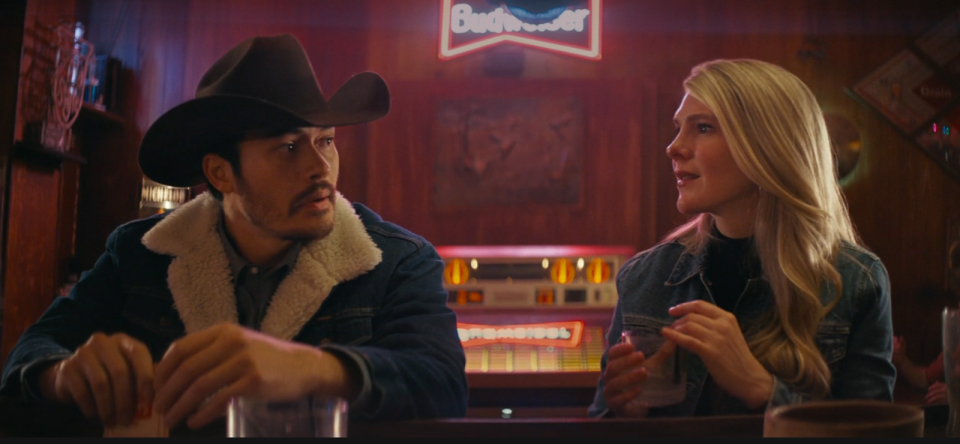‘Downtown Owl’ Review: Lily Rabe Turns Anti-Hero in Puzzling Chuck Klosterman Adaptation

When Chuck Klosterman turned his prodigious talents as a pop culture essayist into his first all-fiction project, the 2008 novel “Downtown Owl,” fans of the writer were treated to some classic Klosterman obsessions (North Dakota, sports, the way entertainment shapes us as humans) in a distinctly new shape. The choppy nature of Klosterman’s novel, which focuses on three very different citizens of tiny, fictional Owl, North Dakota, as they navigate small-town life in the lead-up to a massive blizzard, wasn’t as compelling or entertaining as Klosterman’s other books but there was a charm to its flow and feeling. In short: It wasn’t a great Klosterman effort, but it surely was an interesting one.
More than a decade after its publication, the long-gestating film adaptation of Klosterman’s novel occupies similar territory: not great, but definitely interesting. And, just like the publication of the novel marked a new point in Klosterman’s career, so too does “Downtown Owl” the film signal a new step in the professional pursuits of co-directors (and longtime partners) Hamish Linklater and Lily Rabe, who both make their directorial debut with this curious dramedy.
More from IndieWire
'All That Heaven Allowed' Trailer: Rock Hudson's Legacy Captured in HBO Documentary
A New Academy Museum Podcast Revels in Hollywood Casting Coups and Untapped Trivia
Rabe also stars in the film (Linklater adapts the script; they both produced), which partially explains why the duo opted to turn Klosterman’s three-hander into a more singularly focused feature, orienting the majority of the story around Rabe’s new-in-town Julia in the months leading up to the January blizzard.
It’s a tricky ask: As thrilling as Rabe’s performance eventually becomes, the choice to focus mostly on Julia’s experience and perspective removes much of our investment in Horace (Ed Harris) and Mitch (August Blanco Rosenstein), who were given equal weight in Klosterman’s novel. Still, Rabe’s work here, as a messy, “unlikeable,” and deeply flawed character, is the best part of the film, an anti-hero worth, well, if not cheering for, at least watching with full concentration.
Even those unfamiliar with the film’s source material will know how it ends, as Linklater and Rabe open the film with a brief look at the January 1984 blizzard that swoops through Owl, forever impacting the three key characters. Soon, we’re flashing back to September when Julia rolled into Owl, an outsider about to be steeped in this particular brand of small-town life. She’s taken a teaching job at the local high school to get her away from her unseen husband, first chalking up the short-term assignment to work pressures, later making it plain that their relationship is practically dead, and when she’s not drinking herself silly at one of the town’s local bars, she’s showing up hungover and out of it in her history classes.
Linklater and Rabe lean on some messy affectations to get their story rolling, including everything from the cute (an unnecessary animated sequence that introduces the town) to the ridiculous (Rabe gliding along the high school hallway in a bizarre double dolly shot; constant use of a fisheye lens in wide shots) to the actually quite good (introductions to Julia’s students, including Mitch, that reveal some serious truths in a winking fashion). Mostly, it just takes a while to settle into itself, to get into a compelling and sensical groove.
Then again, that’s also Julia’s experience as she attempts to get hip to Owl life in fits and starts. She’s deluged with new friends and foes, like Vanessa Hudgens as fellow teacher Naomi (an almost unbearably shrill and one-note role that the actress occasionally finds real sparks in), Finn Wittrock as a smooth-talking coach with a secret, Harris as the welcoming older gent Horace, and Henry Golding as former Owl football star Vance Druid. As Julia gets to know the shape of Owl, so too do we — and it’s not always pleasing, as Linklater and Rabe peel off the layers of this particular town with both relish and discomfort. If that sounds awkward, it is.
Julia remains the cracked lens through which we view all of this, an unreliable narrator with a skewed sense of, well, just about everything. The kind Horace provides a respite for the addled Julia, heaping on her both home-cooked meals and home-baked gossip, all the better to obscure what’s really happening with his own life. Julia’s sense of propriety is so warped that she can’t recognize how nefarious Coach Laidlaw (Wittrock) really is, nor how his various misdeeds have impacted a close group of sensitive students (including Rosenstein, Jack Dylan Grazer, and Arianna Jaffier). And she sure as hell can’t come to grips with the blooming obsession she feels for Vance, which reduces her to drunk hysterics on the regular. (Late in the film, as Julia sobs that she feels like she’s not done with her 20s — despite pushing 40 — it feels like one of many keys to the story that are dangled and then snatched away.)
In short (and in very reductive terms), no one in Owl is well, and the looming blizzard is only the next disaster to befall them. How Linklater and Rabe handle that dark truth can be puzzling, leaning on some characters and situations while leaving others to wither, never quite acknowledging the darkness that plagues this place, and ultimately moving toward a wholly unearned conclusion. Klosterman’s vision of this tiny, insulated world was never this neat and tidy, a lesson that has not translated to its cinematic companion. It’s a slice of life, surely, but a meager one at that.
Grade: C+
“Downtown Owl” premiered at the 2023 Tribeca Film Festival. Sony will release it at a later date.
Best of IndieWire
Sign up for Indiewire's Newsletter. For the latest news, follow us on Facebook, Twitter, and Instagram.

 Yahoo Sports
Yahoo Sports 